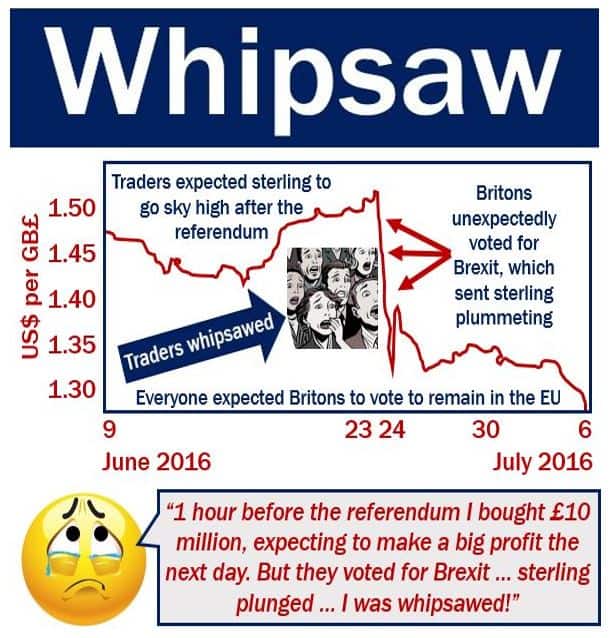Whipsaw – definition and meaning
Whipsaw refers to a loss that a trader incurs when a security suddenly and unexpectedly drops soon after it is purchased. Investors will say that the trader is ‘whipsawed’ when his or her security’s price suddenly moves in the opposite direction of a trade that he or she has just placed.
If a trader, perhaps due to misleading signals, buys stocks just before they fall and/or sells them just before they rise in a volatile market, he or she has been whipsawed.
In general English, a whipsaw is a saw with a narrow blade and a handle at each end – it is generally used by two people. As a verb, it means to cut with a whipsaw.
The financial term originated from the push and pull action that lumberjacks used when cutting wood with a whipsaw. Whipsaw patterns only occur when the market is volatile – when price fluctuations are hard to predict.
 Everybody was so sure that Britons would vote to remain within the EU (European Union) on June 23rd, 2016. The pound sterling, which was worth around $1.50, was expected to jump to $1.65 or even $1.70. Many currency speculators bought billions of pounds, expecting to sell them the next day. However, Britons voted to leave, sterling fell to $1.30, and thousands of traders lost a lot of money – they were whipsawed.
Everybody was so sure that Britons would vote to remain within the EU (European Union) on June 23rd, 2016. The pound sterling, which was worth around $1.50, was expected to jump to $1.65 or even $1.70. Many currency speculators bought billions of pounds, expecting to sell them the next day. However, Britons voted to leave, sterling fell to $1.30, and thousands of traders lost a lot of money – they were whipsawed.
The term may also refer to something that is subject to two opposing pressures simultaneously, as in: “The government has been whipsawed by a smaller budget and a greater spending requirement caused by the recent increase in unemployment.”
This article focuses on the term whipsaw meaning a trader’s loss when the value of a security unexpectedly declines soon after being bought.
Nasdaq.com has the following explanation for ‘whipsawed’:
“Buying stocks just before prices fall and selling stocks just before prices rise in a volatile market, often as the result of misleading signals.”
Being whipsawed is more common among day traders and other short-term investors than for those with a long-term purchase-and-hold approach to investing. Long-term traders are generally able to ride market volatility and end up on the other side with desirable gains.
 A whipsaw market is a volatile market – things first move ‘this way’ and then ‘that way’, and then ‘this way’ again, etc… in the same way that the carpentry tool which is pulled back-and-forth by a person at either end does.
A whipsaw market is a volatile market – things first move ‘this way’ and then ‘that way’, and then ‘this way’ again, etc… in the same way that the carpentry tool which is pulled back-and-forth by a person at either end does.
Whipsaw example
Imagine you have been monitoring the stock of XYZ Inc., a (fictitious) multinational tech giant. Over the past three months, XYZ stocks have been rising steadily, and you expect them to continue appreciating.
Then suddenly, a few hours after making your purchase, XYZ comes out with a quarterly report that scares investors and causes the company’s share price to plummet by 15% – XYZ stocks never recover.
You are holding onto XYZ stocks at a loss, with no way of turning your investment into a profit or break-even – you are effectively whipsawed.
The term whipsaw may also refer to an investor who judges the market wrongly when he or she thinks stocks have hit rock bottom and can only come back up.
Imagine you had bought XYZ shares after a 6-month decline, because you were convinced they would start rising. However, after purchasing them, they continued declining.
The term whipsaw is used in situations when the market is volatile, the trader misreads the signs, and the stock he or she purchases moves in an opposite-to-expected direction.
Whipsaw series
When traders see a trend, take a position, the stocks whipsaw the other way, and this happens again and again, we have a whipsaw series.
In an article published in Business Standard in October 2013, titled ‘How to trade in a whipsaw market’, Devangshu Datta wrote:
“It is necessary for trend-following traders to accept that trends sometimes don’t work — in fact, trends fail more often than those sustain.”
“Prices do have a tendency to revert to the mean. One may see five or six trend failures in succession before a trend sustains and takes off. Trend-following pays only because when trends do sustain they earn vast profits.”
In DayTradingPsychology.com, Dr. Kenneth Reid explains that trading with no technical trading plan puts active traders into emotional and visual reactivity – the more they react, the more frequently they will experience a whipsaw.
Reactivity is what makes traders and investors bearish or bullish at precisely the wrong moments, Dr. Reid added.
Dr. Reid wrote:
“In fact, it’s not unusual for reactive traders to experience the ‘Reverse Midas Touch,’ which means almost everything they do is wrong. In other words, reactivity tends to manifest in trading results that are much worse than chance.”

